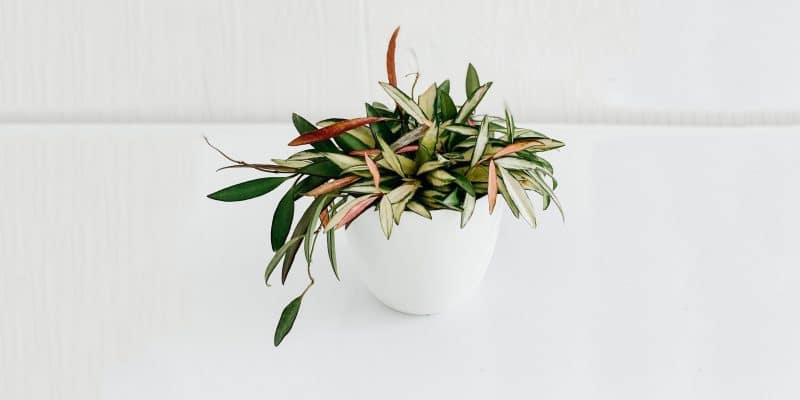Hoya wayetii is one of those rare finds, kind of like discovering a hidden garden in the middle of a bustling city. It’s one of those housplants that just has that extra wow factor.
Its long, cascading vines adorned with striking, elongated leaves make it a showstopper in any space, and soon, you might just find yourself wanting to clear some room for this stunning specimen.
From its origins to its watering needs and everything in between, consider this your ultimate Hoya wayetii care handbook. By the time you finish reading, you’ll be equipped with all the know-how to help your Hoya wayetii thrive.
Table of Contents
Hoya Wayetii Plant Care Guide
History, Habitat, and Characteristics
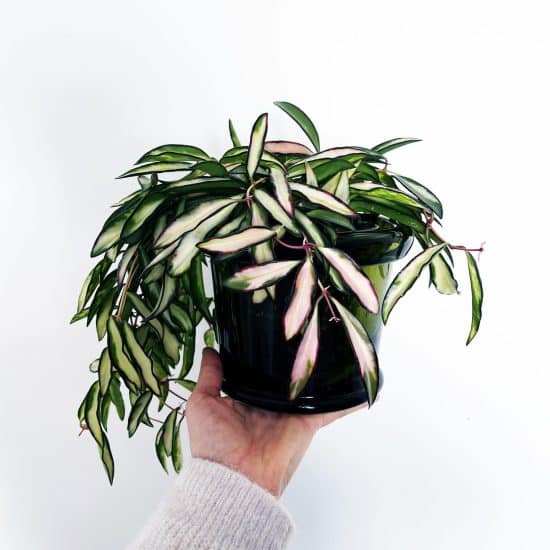
Thriving in the Philippines’ tropical climate, Hoya wayetii can often be found hanging high from tree branches or climbing up their trunks. It’s this tree-dwelling nature that makes it an excellent indoor plant, because epiphytic plants tend to be rather low maintenance.
This marvelous climber is known for its unpredictable yet enchanting variegation, displaying leaves in a mix of green, pink, and cream shades. A sun-lover at heart, when given ample light, the leaf edges transform, boasting a brownish or dark-reddish hue.
It’s worth noting that our dear Hoya wayetii is a bit of a doppelgänger! Often confused with Hoya kentiana due to their similar appearances, these cousins can be told apart by looking for the slightly more compact growth habit, greener stems, and darker foliage of Hoya wayetii.
Fun fact: The variegation on Hoya wayetii’s leaves is so unpredictable and diverse that two leaves on the same plant can look completely different, and each plant is its own unique creation.
Light
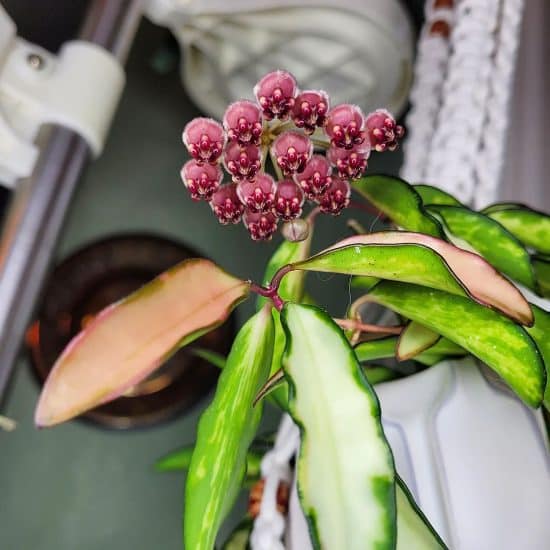
Hoya wayetii, a tropical plant with a trailing growth habit, thrives in plenty of indirect sunlight. Some direct sun in the morning or late afternoon, when the sun’s rays are less harsh, may help it flower, but this isn’t necessary to its survival, and you should avoid direct light when the sun is at its hottest.
Positioning this wax plant (a name synonymous with the Hoya genus) near a west-facing window can help it achieve those stunning reddish leaf margins and maintain its vibrant pink and variegated colors. If you think the light isn’t bright enough, setting it under a grow light for 8-10 hours a day may give it the right amount of natural light to prosper.
Insufficient bright light can cause pale leaves, slow growth, or the plant to lean toward the light source. To fix this, scoot your Hoya wayetii to a brighter spot or add a glow of supplemental lighting.
Too much direct light, though, could harm your hoya plant, leading to scorched leaves, faded colors, or crispy brown leaf edges. If this occurs, it’s time to move your Hoya wayetii away from the spotlight or slide a sheer curtain in front of the window.
Our lighting tips:
- Place your Hoya wayetii in bright, indirect light.
- Avoid too much exposure to direct sunlight.
- Give your hoya plants the full 360° treatment! Rotate the plant every few weeks to ensure all sides receive equal lighting for evenly balanced growth.
Water
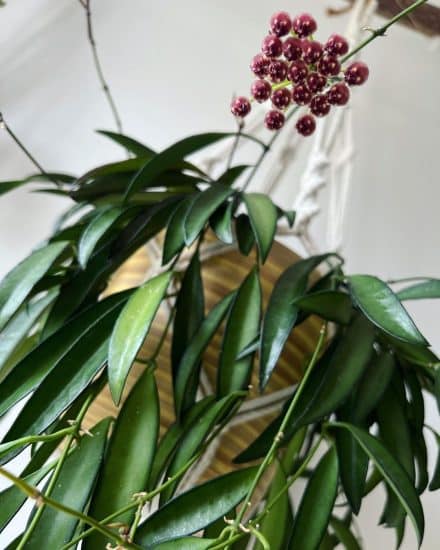
This hoya plant is somewhat drought tolerant because, as a succulent, it holds water in its leaves. Therefore, it’s very easy to overwater.
An underwatered Hoya wayetii will exhibit a few signs, such as shriveling or wrinkling leaves. This is a clear signal to increase hydration, but remember, moderation is key! Allow the soil to dry out between thorough waterings.
Overwatering can cause issues like yellowing leaves, soft and mushy stems, and consistently moist soil. These signs indicate your Hoya wayetii is getting more water than it needs. It’s time to scale back your watering schedule and let the soil surface dry out for a bit.
Our watering tips:
- Stick your finger into the first 1 or 2 inches of soil. If it’s dry, it’s time to water; if not, wait a bit longer.
- Use a pot with drainage holes and a coarse potting soil to prevent waterlogged soil and reduce the risk of wet roots.
- Water less often in the winter, when most hoya plants can go dormant.
- To encourage Hoya wayetii flowers, let your plant dry out even more than usual between waterings and avoid frequent repotting.
Temperature and Humidity
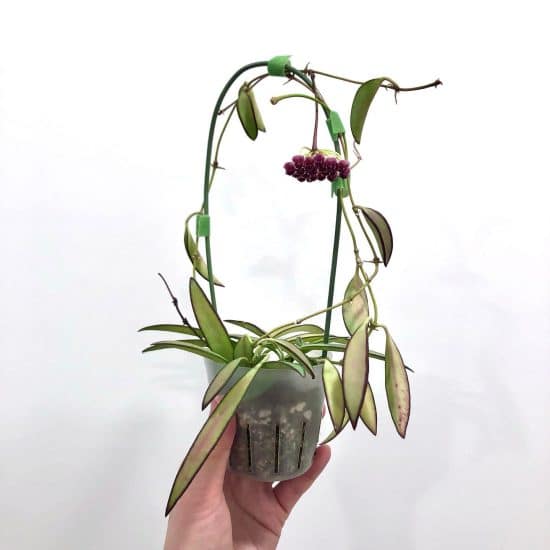
When it comes to temperature, Hoya wayetii plants prefer it a bit on the warmer side — specifically between 60-95°F (15 to 35°C).
Keep an eye out for sudden temperature drops or chilly drafts, which can stress out your Hoya wayetii plant and lead to sad, wilted leaves. On the flip side, sweltering heat can leave the leaves looking discolored, dry, or even scorched.
When it’s hot in the peak of summer, increase the humidity around your Hoya wayetii.
In general, though, aim for a comfortable range of 40% to 60% humidity. If you spot curled or brown leaf edges, it might be a sign that the air is too dry. On the other hand, yellowing leaves or a suspicious moldy smell could indicate excessive humidity, and even fungal infections.
To raise humidity:
- Try placing a tray of water and pebbles underneath your plant pot.
- Group this humidity-loving hoya plant with other plants to increase moisture levels through the magic of transpiration.
- Set up a humidifier in the room where your Hoya wayetii resides.
- Consider relocating your Hoya wayetii plant to a naturally humid area, like a bathroom, as long as it receives enough bright light.
Soil and Planting
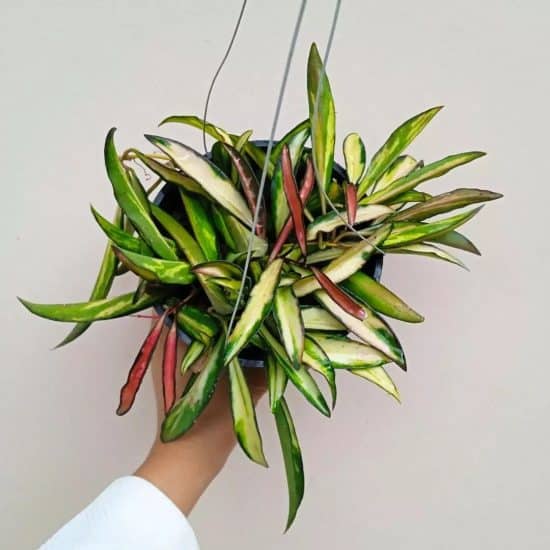
An ideal soil blend for hoyas consists of perlite and a well-draining houseplant potting mix. You could also add coco coir or orchid bark. A well-drained potting soil will be airy and coarse, ensuring proper drainage while still retaining some moisture.
Experimenting with transparent pots can be a game-changer for epiphytic plants like hoyas and orchids because they mimic the roots’ exposure to sun in their native habitat. Clear pots also let you easily monitor the roots so you know when the plant is ready for repotting.
Just keep in mind, hoyas like to be root-bound, and keeping them root-bound may even stimulate the stunning Hoya wayetii flowers. Keep your wax plant in its original nursery pot as long as possible. This will keep its roots happy and prevent the plant from going into shock from moving its location and pot all at once.
Alternatively, hoyas also do well in hanging baskets. If you’re lucky enough that your hoya blooms indoors — with the right lighting, this is totally likely! — its waxy flowers and majestic foliage cascading from the ceiling will make your home look like the Hanging Gardens of Babylon.
Fertilizing
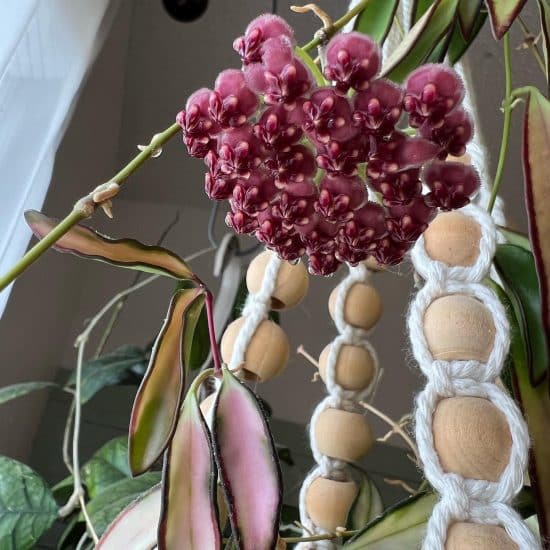
Fertilizing hoya plants isn’t a top priority, but if you want to give yours a little boost, go for a balanced liquid houseplant fertilizer or a high-nitrogen fertilizer. Dilute it to half strength, and apply every 2-3 months during the growing season.
Be cautious, though — over-fertilizing can cause more harm than good. If you see yellow leaves, brown tips, or slow growth, you’ve probably gone overboard with the fertilizer. Simply flush the soil with filtered water several times to remove excess fertilizer and adjust future applications accordingly.
Propagation
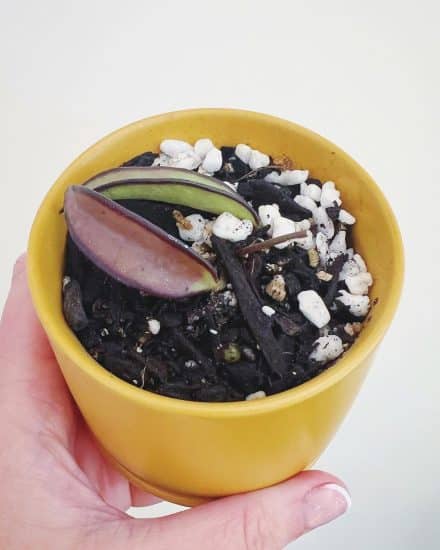
It’s scientifically proven that it’s impossible to have too many Hoya wayetii plants. Just a fact.
And if you’ve promised anyone who shares your living space that you’ll spend less money on other plants this year, you’re in luck. Hoyas are easy to propagate!
Propagating Hoya wayetii via stem cuttings:
- Choose a healthy stem cutting. Select a healthy Hoya wayetii stem from a mature plant with lots of growth. Grab some sterilized gardening shears or a clean, sharp knife, and cut a stem segment with at least two nodes (the points where leaves attach to the stem) and some healthy leaves. Aim for a cutting about 4-6 inches long for the best results.
- Get stem cuttings ready for rooting. Gently remove any leaves from the bottom node, so it’s exposed for rooting. This also stops leaves from rotting in the water.
- Pop the cutting in water. Fill a small container or glass with filtered, room temperature water, and carefully place your cutting inside. Make sure the bottom node is submerged, and place the container in a spot with bright, indirect sunlight.
- Keep an eye on rooting progress. Change the water every 2-3 days to keep it clean and fresh. In a few weeks, you’ll likely see small white roots sprouting from the bottom node.
- Shift your rooted cutting to a planting medium. When the roots are about 2 inches long, it’s time to move your cutting to a well-drained potting mix. Gently plant your cutting in a small pot or container, being careful with the delicate roots.
Our propagation tips:
- Use a clear glass or vase so you’re able to monitor the rooting progress.
- Remember, rooting can take time, so be patient.
- Always use clean, sterilized tools and fresh water to prevent infections or diseases in your cuttings or on the parent plant.
- While Hoya wayetii can be propagated throughout the year, you’ll have a better chance of success if you do it during the spring and summer.
Common Issues
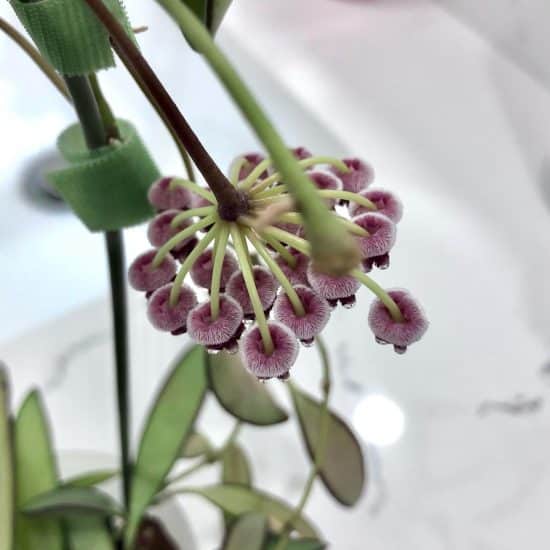
Yellow Leaves
Yellow leaves might indicate that your Hoya wayetii is receiving too much water. To resolve this problem, wait for the soil to dry out before giving your plant a thorough watering, and ensure that the pot has sufficient drainage to prevent water from accumulating at the bottom.
Sometimes, nutrient deficiencies in the soil could also be responsible for yellow leaves. In such cases, applying a balanced, water-soluble fertilizer once a month will provide your Hoya wayetii with the nutrients it needs to stay vibrant and healthy.
Loss of Variegation
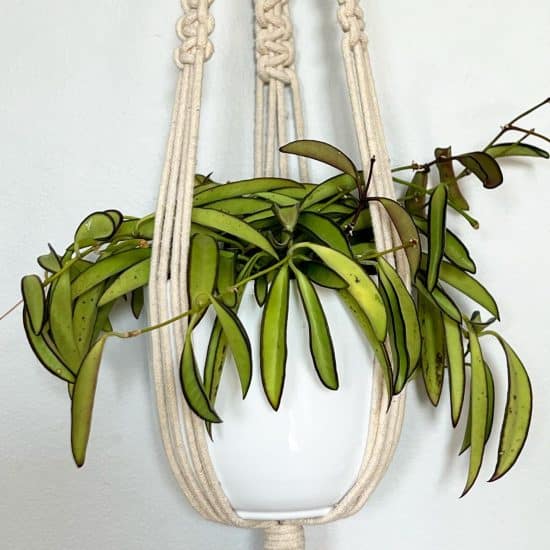
Insufficient sunlight may cause your variegated Hoya wayetii to lose its stunning variegation and pink hues. Variegated hoya plant varieties require adequate light exposure to maintain their vivid colors and well-defined patterns. If your plant is losing its variegation, place it in a well-lit area that receives bright, indirect sunlight.
Keep in mind, however, that excessive direct sunlight might cause its deep green leaves to turn yellow or brown. To strike the perfect balance, try positioning your Hoya wayetii near an east- or north-facing window, where it can enjoy bright but filtered light throughout the day.
Pests and Diseases
Everyone faces challenges now and then, and the robust Hoya wayetii is no exception. No worries, though! We’re here to guide you through identifying and fixing any issues that may arise, ensuring your plant stays healthy and happy.
Root Rot
Root rot is a common issue for many indoor houseplants, including the Hoya wayetii. It commonly results from overwatering and insufficient drainage. To spot this issue, look for discolored, mushy roots, wilting or yellowing leaves, and a rotten smell coming from your wax plant.
To fix root rot:
- Carefully take your Hoya wayetii out of its pot and trim away the affected roots.
- Rinse out the pot and discard the soggy soil mix.
- Repot the plant in a fresh, well-drained potting mix with perlite or pumice mixed in.
- Allow the soil to dry out between waterings and watch your watering frequency.
White Spots
White spots on your Hoya wayetii might be caused by either fungal infections or mineral deposits from tap water. To determine the cause, check your water for high mineral content, which might be the source.
If mineral deposits are the cause:
- Switch to filtered or rainwater to avoid mineral buildup on the leaves.
- Clean the affected leaves with a damp cloth to remove those pesky white spots.
If a fungus is the cause:
- Isolate the infected plant to keep the fungus from spreading to other hoya plants.
- Remove the affected leaves and stems, and apply a horticultural oil solution or spray according to the product’s instructions.
- Maintain proper air circulation and avoid very humid conditions to prevent any future fungal issues.
Fungus Gnats
Fungus gnats are small, winged insects that can be a nuisance to indoor plants, including Hoya wayetii. While they don’t typically cause severe damage, their larvae can feed on the plant’s roots, leading to stunted growth and yellowing leaves.
Additionally, their presence can be an indication of overly moist soil conditions.
To control and prevent fungus gnats:
- Allow the top layer of soil to dry out between waterings, as this discourages gnat larvae from thriving.
- Use sticky traps to capture adult gnats and monitor their population.
- Apply a layer of sand, gravel, or decorative pebbles to the soil surface. This will make it difficult for the gnats to lay their eggs and for larvae to access the soil.
- If the infestation is severe, you can treat your plant with a neem oil or an insecticide spray designed for fungus gnats. Just follow the instructions listed on the container, and reapply in a few weeks to disrupt their lifecycle.
Conclusion
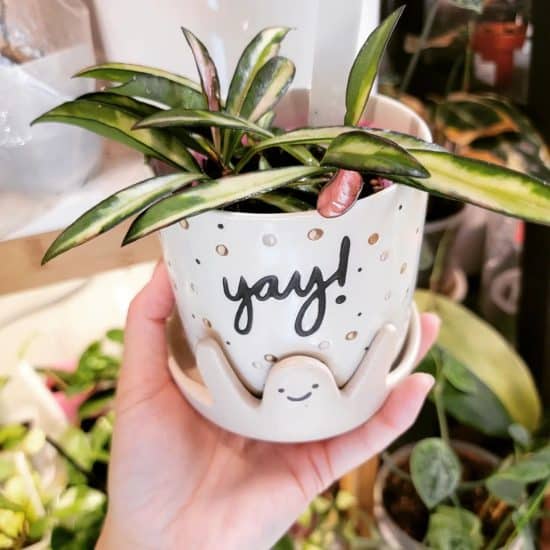
That’s a wrap for our Hoya wayetii care guide!
With its irresistible variegated foliage and relatively easy care requirements, Hoya wayetii is an excellent choice for plant lovers of all skill levels.
Hoya wayetii care summary:
- Position your plant in bright, indirect sunlight, and ensure it receives adequate light to maintain its vibrant variegation and encourage flowering.
- Water your Hoya wayetii when the soil feels dry to the touch, but avoid overwatering to prevent root rot.
- Aim for a comfortable temperature range of 60-95°F (15-35°C) and a humidity level of 40% to 60%.
- Use a well-draining soil mix with bark and perlite for optimal growth.
We hope this guide has provided you with the knowledge and confidence to care for your Hoya wayetii successfully. If you found this guide helpful, don’t hesitate to share it with fellow plant collectors!
FAQ
Are Hoya kentiana and Hoya wayetii the same?
No. Hoya kentiana and Hoya wayetii are often mistaken for one another, owing to their similar appearance and growth habits. However, these close cousins are not entirely the same.
Hoya kentiana boasts pink stems and slightly longer, more lanceolate leaves, while Hoya wayetii’s stems are green and its leaves are not quite as long.
Is Hoya wayetii a succulent?
Yes, Hoya wayetii plants are indeed considered succulents. Hoya wayetii has thick, fleshy leaves capable of storing water — allowing the plant to survive periods of drought quite well.
This water retention trait is what classifies Hoya wayetii as a succulent, making it an excellent low-maintenance choice for gardening enthusiasts, and a favorite among those who appreciate the unique beauty of succulent plants.
Is Hoya wayetii toxic?
Hoya wayetii, like most hoyas, is considered to be nontoxic to humans. However, use caution if you have curious pets.
While the plant isn’t classified as toxic, it may still cause mild irritation if ingested by cats or dogs. It’s always wise to keep your Hoya wayetii (and other houseplants) out of reach to ensure your furry friends’ safety.

